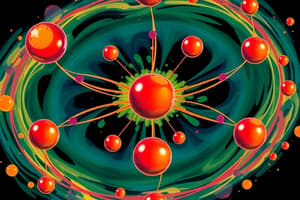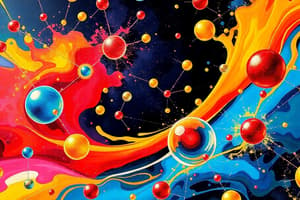Podcast
Questions and Answers
What does the Kinetic Molecular Theory explain?
What does the Kinetic Molecular Theory explain?
The Kinetic Molecular Theory explains the properties of solids and liquids in terms of intermolecular forces of attraction and the kinetic energy of the individual particles.
What are the four postulates of the Kinetic Molecular Theory?
What are the four postulates of the Kinetic Molecular Theory?
- All matter is made up of tiny particles.
- These particles are in constant motion.
- The speed of particle is proportional to temperature. Increased temperature means greater speed.
- Solids, liquids, and gases differ in distances between particles, in the freedom of motion of particles, and in the extent to which the particles interact.
Which of the following is NOT a true statement about the Kinetic Molecular Theory?
Which of the following is NOT a true statement about the Kinetic Molecular Theory?
- The particles are in constant motion.
- The particles interact with each other.
- All matter is made up of tiny particles.
- The speed of the particles is inversely proportional to temperature. (correct)
What are the three states of matter, as illustrated by the Kinetic Molecular Theory?
What are the three states of matter, as illustrated by the Kinetic Molecular Theory?
Match the following properties of matter with the appropriate state of matter:
Match the following properties of matter with the appropriate state of matter:
What are intermolecular forces?
What are intermolecular forces?
What is the main difference between intermolecular and intramolecular forces?
What is the main difference between intermolecular and intramolecular forces?
Which of the following is NOT a type of van der Waals force?
Which of the following is NOT a type of van der Waals force?
Dipole-dipole forces exist between polar molecules, where one end of a dipole attracts the oppositely charged end of another dipole.
Dipole-dipole forces exist between polar molecules, where one end of a dipole attracts the oppositely charged end of another dipole.
What is hydrogen bonding?
What is hydrogen bonding?
What does the term 'electronegativity' mean in the context of hydrogen bonding?
What does the term 'electronegativity' mean in the context of hydrogen bonding?
Explain ion-dipole forces.
Explain ion-dipole forces.
Describe London dispersion forces.
Describe London dispersion forces.
What are dipole-induced dipole forces?
What are dipole-induced dipole forces?
What is surface tension?
What is surface tension?
Which of the following is NOT an example of surface tension?
Which of the following is NOT an example of surface tension?
Why do water droplets form spherical shapes?
Why do water droplets form spherical shapes?
What is capillary action?
What is capillary action?
Explain the difference between cohesion and adhesion in the context of capillary action.
Explain the difference between cohesion and adhesion in the context of capillary action.
What determines the shape of the meniscus in a liquid?
What determines the shape of the meniscus in a liquid?
What is viscosity?
What is viscosity?
Which of the following liquids would you expect to have the highest viscosity?
Which of the following liquids would you expect to have the highest viscosity?
How does intermolecular attraction strength affect viscosity?
How does intermolecular attraction strength affect viscosity?
Long-chained substances, like oil, have greater intermolecular forces, contributing to their higher viscosity, because they have more atoms that can attract one another.
Long-chained substances, like oil, have greater intermolecular forces, contributing to their higher viscosity, because they have more atoms that can attract one another.
Explain how vapor pressure works.
Explain how vapor pressure works.
What factors affect vapor pressure?
What factors affect vapor pressure?
What is the boiling point of a liquid?
What is the boiling point of a liquid?
The boiling point of a liquid is independent of the external pressure.
The boiling point of a liquid is independent of the external pressure.
How does the strength of intermolecular forces affect the boiling point of a liquid?
How does the strength of intermolecular forces affect the boiling point of a liquid?
What is the heat of vaporization?
What is the heat of vaporization?
Which of the following statements about the heat of vaporization is TRUE?
Which of the following statements about the heat of vaporization is TRUE?
Which of the following states of matter has the highest degree of order among its particles?
Which of the following states of matter has the highest degree of order among its particles?
What are phase changes?
What are phase changes?
Which of the following is NOT considered a phase change?
Which of the following is NOT considered a phase change?
Match the following phase changes to their respective descriptions:
Match the following phase changes to their respective descriptions:
What is a phase diagram?
What is a phase diagram?
Describe the triple point on a phase diagram.
Describe the triple point on a phase diagram.
What is a supercritical fluid?
What is a supercritical fluid?
Flashcards
What is the Kinetic Molecular Theory?
What is the Kinetic Molecular Theory?
The Kinetic Molecular Theory explains the properties of solids and liquids in terms of intermolecular forces of attraction and the kinetic energy of the individual particles.
What is the first postulate of the Kinetic Molecular Theory?
What is the first postulate of the Kinetic Molecular Theory?
All matter is made up of tiny particles.
What is the second postulate of the Kinetic Molecular Theory?
What is the second postulate of the Kinetic Molecular Theory?
These particles are in constant motion.
What is the third postulate of the Kinetic Molecular Theory?
What is the third postulate of the Kinetic Molecular Theory?
Signup and view all the flashcards
What is the fourth postulate of the Kinetic Molecular Theory?
What is the fourth postulate of the Kinetic Molecular Theory?
Signup and view all the flashcards
What are intermolecular forces?
What are intermolecular forces?
Signup and view all the flashcards
How strong are intermolecular forces compared to intramolecular forces?
How strong are intermolecular forces compared to intramolecular forces?
Signup and view all the flashcards
What are intramolecular forces?
What are intramolecular forces?
Signup and view all the flashcards
What is another name for intermolecular forces of attraction?
What is another name for intermolecular forces of attraction?
Signup and view all the flashcards
What is a dipole-dipole force?
What is a dipole-dipole force?
Signup and view all the flashcards
What is hydrogen bonding?
What is hydrogen bonding?
Signup and view all the flashcards
What is an ion-dipole force?
What is an ion-dipole force?
Signup and view all the flashcards
What is a London dispersion force?
What is a London dispersion force?
Signup and view all the flashcards
What is a dipole-induced dipole force?
What is a dipole-induced dipole force?
Signup and view all the flashcards
What is surface tension?
What is surface tension?
Signup and view all the flashcards
What is capillary action?
What is capillary action?
Signup and view all the flashcards
What is viscosity?
What is viscosity?
Signup and view all the flashcards
What is vapor pressure?
What is vapor pressure?
Signup and view all the flashcards
What is the boiling point of a liquid?
What is the boiling point of a liquid?
Signup and view all the flashcards
What is molar heat of vaporization?
What is molar heat of vaporization?
Signup and view all the flashcards
What is a crystalline solid?
What is a crystalline solid?
Signup and view all the flashcards
What is an amorphous solid?
What is an amorphous solid?
Signup and view all the flashcards
What is a unit cell?
What is a unit cell?
Signup and view all the flashcards
What is a phase diagram?
What is a phase diagram?
Signup and view all the flashcards
What is the triple point?
What is the triple point?
Signup and view all the flashcards
What is the critical point?
What is the critical point?
Signup and view all the flashcards
What is a supercritical fluid?
What is a supercritical fluid?
Signup and view all the flashcards
What is sublimation?
What is sublimation?
Signup and view all the flashcards
What is deposition?
What is deposition?
Signup and view all the flashcards
What is vaporization?
What is vaporization?
Signup and view all the flashcards
What is condensation?
What is condensation?
Signup and view all the flashcards
What is melting?
What is melting?
Signup and view all the flashcards
What is freezing?
What is freezing?
Signup and view all the flashcards
Study Notes
General Chemistry II - Chapter 1
- The Kinetic Molecular Model and Intermolecular Forces of Attraction in Matter are studied in this chapter.
- Kinetic Molecular Theory explains the properties of solids and liquids in terms of intermolecular forces of attraction and kinetic energy of individual particles.
- All matter is made of tiny particles in constant motion.
- Particle speed is proportional to temperature. Higher temperature means greater speed.
- Solids, liquids, and gases differ based on distances between particles, freedom of motion, and how much particles interact.
Section 1.1: Kinetic Molecular Theory of Solids and Liquids
- The aim is to understand why solids and liquids behave differently.
- Kinetic Molecular Theory provides a framework to explain solid and liquid behavior based on intermolecular attractive forces.
Kinetic Molecular Theory
- Matter consists of tiny particles.
- These particles are in constant motion.
- Particle speed is proportional to the temperature.
- Solids, liquids, and gases differ in the distances between particles, the freedom of particle motion, and the extent of particle interaction.
States of Matter
- Solids, liquids, and gases are visualized in drawings depicting particle arrangements.
Activity 1
- Compare distances between molecules in gas, liquid and solid, rank phases in increasing distance.
- Describe the characteristic movement of gas, liquid and solid particles.
- Explain molecular arrangements in gas, liquid and solid.
- Order the three phases of matter based on increasing volume of empty space.
Properties of Matter: Molecular Behavior
- Volume/Shape: Gases assume container volume and shape, liquids have a fixed volume but take container shape, solids have a fixed volume and shape.
- Density: Gases have low density, liquids have high density, and solids have high density.
- Compressibility: Gases are easily compressed, liquids are not appreciably compressible, and solids are not appreciably compressible.
- Motion of Molecules: Gas molecules move randomly and quickly, covering large distances, liquid molecules have medium speeds, and move in limited distances. Solids have molecules vibrating in fixed positions.
Intermolecular Forces of Attraction
- Attractive forces between molecules or particles in solids and liquids.
- These forces are weaker than intramolecular forces (bonds within molecules).
- Several types of intermolecular forces exist: Dipole-dipole, Hydrogen bonding, Ion-dipole, London dispersion, and Dipole-induced dipole.
Dipole-Dipole Forces
- Exist between polar molecules.
- One dipole end attracts the oppositely charged end of another dipole.
Hydrogen Bonding
- A special and very strong type of dipole-dipole force.
- Occurs between a hydrogen atom bonded to a small and highly electronegative non-metal atom (e.g., N, F, O).
- Common in molecules containing H, N, F, and O.
Ion-Dipole Force
- Acts between an ion (positive or negative) and a polar molecule (like water).
- Explains the solubility of ionic compounds in water.
- Ions and water molecules overcome attraction between ions, separating the ion and surrounding it with water molecules.
London Dispersion Forces
- The weakest type of intermolecular force.
- Forms between nonpolar molecules due to transient dipole moments caused by temporary electron shifts.
- Often called induced dipole-induced dipole attraction.
Dipole-Induced Dipole Forces
- Interaction between polar and nonpolar molecules.
- The polar molecule induces a dipole moment in the nonpolar molecule.
Section 1.3: Intermolecular Forces and Properties of Liquids
- How intermolecular forces affect liquid behavior.
- Properties of liquids and intermolecular forces.
Intermolecular Forces and Properties of Liquids
- Liquids have no simple or regular structure. Intermolecular forces determine their properties.
- The properties related to intermolecular forces such as surface tension, viscosity, capillary action, vapor pressure, boiling point, and heat of vaporization.
Surface Tension
- Measure of elastic force in a liquid surface.
- Energy required to stretch or increase a liquid surface by a unit area.
- Manifested as skin or a spherical shape of liquids.
- Needles and paper clips can float on water.
- Liquids with strong intermolecular forces have high surface tension.
Capillary Action
- Tendency of a liquid to rise in a narrow tube or opening due to intermolecular forces between the liquid and the solid material.
- Attraction between liquid and solid material leads to capillary action.
- Cohesion is attraction between like molecules, while adhesion is the attraction between different molecules.
- Surface shape (convex or concave) depends on cohesive and adhesive forces.
Viscosity
- Resistance of a liquid to flow.
- Described as thickness or thinness.
- Liquids with strong intermolecular forces have higher viscosities due to greater internal friction.
- Long-chained molecules (e.g., oil) contribute to higher viscosity due to stronger intermolecular forces.
Vapor Pressure
- Pressure exerted by vapor when in equilibrium with liquid/solid.
- Liquid evaporates in closed container, exerting pressure above liquid.
- Substances with stronger intermolecular forces have lower vapor pressures as escape is harder.
Boiling Point
- Temperature at which vapor pressure equals atmospheric pressure.
- Liquid transforms to gas; bubbles rise and leave the liquid surface.
- Atmospheric pressure affects boiling point. A decrease in altitude leads to a drop in boiling point.
- Stronger intermolecular forces result in a higher boiling point.
Heat of Vaporization
- Amount of heat required to vaporize 1 mole of substance at its boiling point.
- Heat disrupts intermolecular forces, allowing molecules to vaporize.
- Boiling points tend to increase with higher molar heat of vaporization.
Structure and Properties of Water
- Pure water is a colorless, odorless, and tasteless liquid at room temperature.
- Turns into ice (solid) at 0°C and 1 atm.
- Becomes steam (gas) at 100°C.
Unique Properties of Water
- Good solvent.
- High specific heat (amount of energy to raise the temperature of 1 gram of substance by 1°C).
- Unusually high boiling point.
- Solid water is less dense than liquid water (ice floats). Hydrogen bonds create an open structure in ice, making it less dense than liquid.
Section 1.4: Types and Properties of Solids
- Crystalline and amorphous solids are differentiated based on particle arrangement.
- Crystalline solids have highly regular arrangements, while amorphous solids have disordered arrangements.
Amorphous Solids
- Solids like glass, that form rapidly, where constituent particles do not have time to align or crystallize.
Crystalline Solids
- Solids with well-defined crystal lattices.
- A lattice is a three-dimensional system of points representing locations of components.
- Unit cell is the smallest repeating unit of a crystal lattice.
- Different crystal structures are possible, each with different unit cells.
Classification of Crystalline Solids
- Types of crystalline solids and their properties: Ionic (ions), Molecular (molecules), Metallic (metal atoms), Network (nonmetal atoms), Group 8A (noble gases).
- Properties of each type of crystalline solid (hardness, melting point, conductivity).
- Examples of each solid type.
Section 1.5: Phase Changes and Phase Diagrams
- Understand phases of matter & conditions that trigger phase changes.
- Explain how energy affects phase changes.
- Discuss how phase diagrams are used.
Phase Changes
- Transformations of matter from one physical state to another (solid, liquid, gas).
- Occur when energy is added or removed.
- Characterized by changes to molecular order. (solid most ordered, gas most disordered).
Types of Phase Changes
- Melting (solid to liquid)
- Freezing (liquid to solid)
- Vaporization (liquid to gas)
- Condensation (gas to liquid)
- Sublimation (solid to gas)
- Deposition (gas to solid)
Phase Diagrams
- Graphs of Pressure vs. Temperature.
- Show possible combinations of pressure and temperature at which phases are observed.
- Identify regions for solid, liquid, and gas phases.
Features of Phase Diagrams
- Three areas for solid, liquid, and gas phases.
- Three lines (melting/freezing, vaporization/condensation, sublimation/deposition). Equilibrium between two phases.
- Important points: Triple point (all three phases coexist), Critical point (liquid and gas phases merge).
Key Points of Phase Diagrams
- Melting/Freezing Curve: Separates solid and liquid phases, melting and freezing points.
- Vaporization/Condensation Curve: Separates liquid and gas phases; condensation and vaporization points; also describes how pressure influences the boiling point.
- Sublimation/Deposition Curve: Separates solid from gas phases; solid to gas and gas to solid transitions. Triple point where all three phases are in equilibrium. Critical point where there is no distinction between phases and it can be considered a single phase. Pressure at critical point is called critical pressure. Temperature at critical point is called critical temperature. Beyond critical temperature and critical pressure, a supercritical fluid exists.
Activity 2 (Specific Intermolecular Force identification and justification)
- Details about identifying the intermolecular force in each substance and why.
LPG (Liquefied Petroleum Gas)
- LPG is a flammable mixture of hydrocarbon gases. It can be liquefied under certain conditions and used as fuel.
Studying That Suits You
Use AI to generate personalized quizzes and flashcards to suit your learning preferences.




